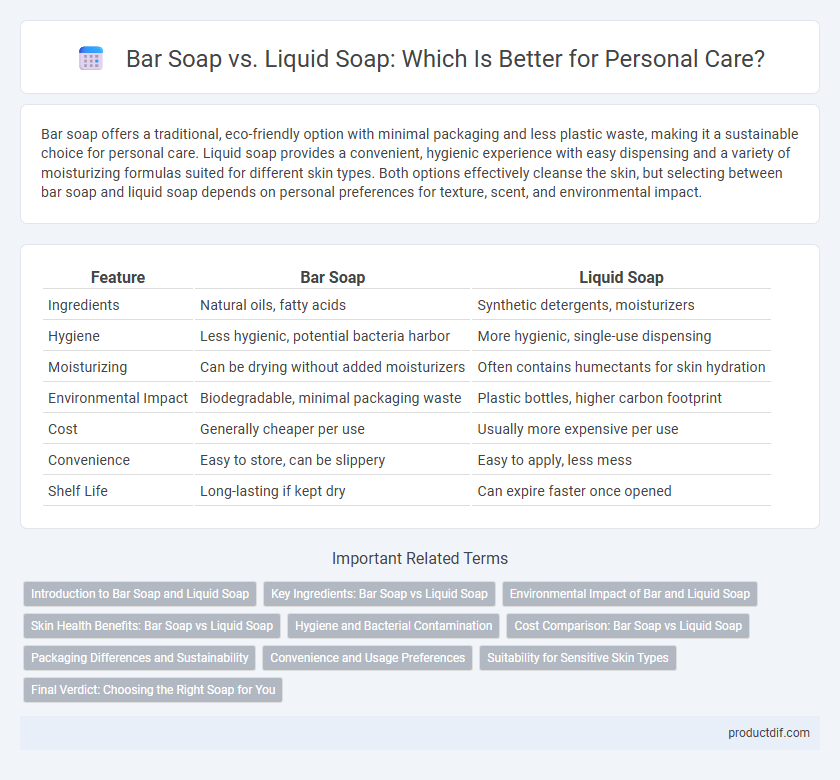Bar soap offers a traditional, eco-friendly option with minimal packaging and less plastic waste, making it a sustainable choice for personal care. Liquid soap provides a convenient, hygienic experience with easy dispensing and a variety of moisturizing formulas suited for different skin types. Both options effectively cleanse the skin, but selecting between bar soap and liquid soap depends on personal preferences for texture, scent, and environmental impact.
Table of Comparison
| Feature | Bar Soap | Liquid Soap |
|---|---|---|
| Ingredients | Natural oils, fatty acids | Synthetic detergents, moisturizers |
| Hygiene | Less hygienic, potential bacteria harbor | More hygienic, single-use dispensing |
| Moisturizing | Can be drying without added moisturizers | Often contains humectants for skin hydration |
| Environmental Impact | Biodegradable, minimal packaging waste | Plastic bottles, higher carbon footprint |
| Cost | Generally cheaper per use | Usually more expensive per use |
| Convenience | Easy to store, can be slippery | Easy to apply, less mess |
| Shelf Life | Long-lasting if kept dry | Can expire faster once opened |
Introduction to Bar Soap and Liquid Soap
Bar soap is a solid cleansing product made from natural fats or oils combined with an alkali, offering a traditional and eco-friendly option for personal care. Liquid soap, formulated using similar base ingredients but processed into a liquid form, provides ease of use and convenience, especially for handwashing and showering. Both products effectively remove dirt and bacteria, with bar soap often preferred for its minimal packaging waste and liquid soap favored for its hygienic dispensing.
Key Ingredients: Bar Soap vs Liquid Soap
Bar soap typically contains natural fats or oils like coconut oil, palm oil, and shea butter, which provide moisturizing properties and create a solid, cleansing base. Liquid soap often includes surfactants such as sodium lauryl sulfate or sodium laureth sulfate combined with added moisturizers like glycerin or aloe vera to balance cleansing and hydration. Both formulations may incorporate antibacterial agents and fragrances, but their ingredient profiles influence texture, lather production, and skin feel differently.
Environmental Impact of Bar and Liquid Soap
Bar soap has a significantly lower environmental impact compared to liquid soap due to its minimal packaging, often using biodegradable materials or no packaging at all. Liquid soap typically requires plastic bottles that contribute to landfill waste and higher carbon emissions during production and transportation because of its heavier weight and water content. Choosing bar soap reduces plastic pollution and energy consumption, making it a more sustainable option for personal care.
Skin Health Benefits: Bar Soap vs Liquid Soap
Bar soap typically contains fewer preservatives and artificial ingredients, which can reduce skin irritation and maintain the skin's natural moisture barrier more effectively. Liquid soap often includes added moisturizers and antibacterial agents that may benefit certain skin types but can also lead to dryness or sensitivity with frequent use. Choosing between bar and liquid soap depends on individual skin needs, with bar soap favored for gentle cleansing and liquid soap preferred for targeted hydration or protection.
Hygiene and Bacterial Contamination
Bar soap provides effective removal of dirt and bacteria through direct friction during use, but it may harbor bacteria on its surface if not stored properly. Liquid soap is dispensed from a sealed container, reducing the risk of cross-contamination and bacterial growth commonly associated with shared bar soaps. Studies show liquid soaps often maintain higher hygiene standards in public or communal settings due to their controlled usage and minimal exposure to contaminants.
Cost Comparison: Bar Soap vs Liquid Soap
Bar soap generally costs less per use than liquid soap due to lower packaging and production expenses, making it a more budget-friendly option for personal care routines. Liquid soap often comes in convenient pump bottles that can increase the overall price and may lead to quicker consumption, raising the cost over time. Consumers seeking cost-efficiency typically find bar soap offers better value without compromising cleanliness or skin care benefits.
Packaging Differences and Sustainability
Bar soap typically uses minimal packaging, often wrapped in recycled paper or cardboard, significantly reducing plastic waste compared to liquid soap, which is usually stored in single-use plastic bottles. The production and disposal of plastic liquid soap containers contribute to environmental pollution and carbon emissions, whereas bar soaps, with their compact, biodegradable packaging, offer a more sustainable option. Consumers seeking eco-friendly personal care choices benefit from bar soap's lower environmental footprint due to its minimal and recyclable packaging materials.
Convenience and Usage Preferences
Bar soap offers a compact, travel-friendly design that reduces plastic waste and is easy to store, making it ideal for minimalistic and eco-conscious users. Liquid soap provides a hygienic pump dispenser that minimizes contact and is preferred in shared or public settings for convenience and ease of use. User preferences often depend on lifestyle needs, with bar soap favored for its simplicity and liquid soap chosen for quick, mess-free application.
Suitability for Sensitive Skin Types
Bar soap formulated with moisturizing ingredients like glycerin and shea butter is often gentler on sensitive skin, reducing the risk of irritation and dryness. Liquid soap with added emollients and pH-balanced formulas provides controlled cleansing without stripping natural oils, making it suitable for delicate skin. Choosing fragrance-free, hypoallergenic versions of either soap type enhances comfort and minimizes allergic reactions for sensitive skin users.
Final Verdict: Choosing the Right Soap for You
Bar soap offers a solid, eco-friendly option with minimal packaging, ideal for those seeking cost-effective and environmentally conscious personal care. Liquid soap provides enhanced hygiene with convenient dispensers and moisturizing formulas suited for sensitive skin. Selecting the right soap depends on individual preferences for texture, convenience, scent variety, and skin type compatibility.
bar soap vs liquid soap Infographic

 productdif.com
productdif.com